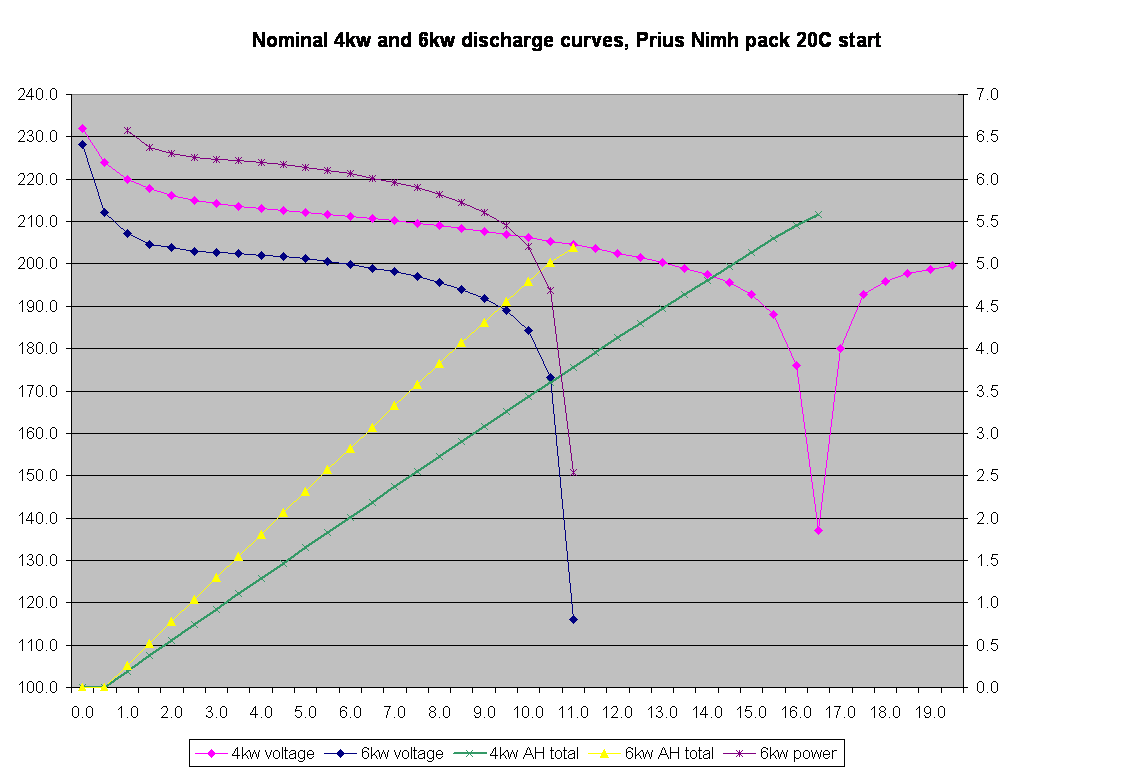 |
Test Summary and Conclusions
I started testing, gingerly, to find out if draining unprogrammed current from the Prius HV section would cause problems with the car or control computer. I decided to conclude the test at the 2.4kW level because this was approaching the rating of my interconnections, and I felt that I had learned all I needed to with the tests I did perform.
Error analysis
If you review the test results, you will see them nicely calibrated in Watts, from 50 to 2400. Of course nothing is that precise, but for a feasibility study, it doesn't really matter if it's 2200, 2400, or 2600 W. If my goal were greater precision, I would have to take into account some second order errors:
| Error Source | Cause of Error | Significance compared to actual power |
| Instrumentation | The DVM was by far the most precise and accurate device in this test. Although I didn't send it in to NBS for calibration, there's no reason to believe it's in error in front of the fourth or fifth decimal place. | None |
| Connecting cable | The long cable connecting the car to the test cart has a voltage drop, perhaps as much as several volts. This will make the voltage read low, and hence make all measurements low, i.e., make it seem like the car is delivering less power than it is. | Reads lower power |
| Bulbs rated for 230V | I used common incandescent lamps, which are nominally rated to consume their power at 230V. The voltages measured during the test ranged from 231 at the top of the battery charge to about 208 at the bottom, right before the engine kicked in. Thus, for the majority of each test the bulbs were taking less power than their rating. | Reads higher power |
| Nonlinear filament | Tungsten filaments are nonlinear due to heating effects. Thus running the bulbs at lower than nominal voltage doesn't reduce the power by as much as would be expected by P=E^2/R because R isn't constant. | Reads lower power |
| Current measuring resistors | Each load branch had a 1.7 ohm power resistor in series to measure voltage drop, and hence current in that branch. This would tend to reduce the total voltage across the lamp. | Reads higher power |
| Car base load | The car circuitry itself requires current to operate - that's how I can take pictures of the charging bars while running the tests. This is an additional load that I didn't add, although with some effort it could have been calculated or even measured. | Reads lower power |
"Reads higher power" above means that my "reading," which was the simple addition of the light bulb wattages, would be higher than actual due the contribution of the error in question.
Test Analysis and Extrapolation
At no time during the test, including the half-hour 2.4kW load test, did the Prius exhibit any symptoms or stigmata of distress. As the load current was increased the engine turned on and stayed on for a longer period to recharge the batteries. This is exactly what one would expect, and nothing untoward was observed. At the higher load levels the auto cooling fan would also come on during a portion of the engine operation cycle. Since the car was stationary, this is expected behavior.
Accordingly, I conclude that the Prius is capable, based on the actual test, of providing 2.4kW power at a nominal 220VDC.
Now for the interesting part. In the latter two tests I carefully timed the engine on/engine off periods. I was curious to see how much engine time was necessary to provide the battery charge to keep the load going continuously. Here's the data in tabular form:
| Load | Time ON | Time OFF | Duty Cycle | Engine Power Supplied |
| 2000 W | 2m 42s | 5m 2s | 35% | 5.7kW |
| 2400 W | 2m 53s | 4m 14s | 41% | 5.9kW |
The "Engine Power Supplied" comes from a conservation argument: The engine must supply (at least) the full load power for the full on/off period to prevent discharging the batteries. Since it does so for a fraction of the time, it must provide at least (load)/(duty cycle) power for the period it is on.
Without going crazy extrapolating to higher loads, or guessing about efficiency or lack thereof in the battery charge/discharge cycle, I think it is reasonable to conclude that the Prius is capable of providing between 5 and 6kW of continuous power without exceeding any ratings or doing anything beyond what is normally expected of it.* Compare this type of operation with normal driving, which typically requires about 5-10kW depending on speed, and obviously is performed continuously for hours at a time on the Interstates. In addition to the normal driving base load, the car retains power for passing, climbing hills, etc.
Another point of comparison is the Prius specification sheet, which indicates that this is very comfortably within the vehicle's ratings.
Conclusion
The tests I have performed appear to confirm the possibility of using the Prius as a source of electric power, with a 5kW rating and a voltage output nominally between 210 and 235V (at the vehicle terminals). I further found no reason why this power can't be taken "continuously" as long as the gas tank is periodically replenished.
The actual tests were limited to 2.4kW and 30 minutes and the above conclusion was extrapolated from them for the reasons given. Additionally, because the power is coming primarily from rechargeable cells, and their circuit is fused at 120A, it would seem that there is the possibility of taking peak power of at least 21kW (based on the specifications) and possibly even more for very brief periods. This assertion has not been tested by me-I don't have enough plywood to mount all the lightbulbs.
Obligatory Safety Notes
These tests were performed with the Prius outdoors. Although carbon monoxide emissions are low, they are certainly not zero. Anyone attempting to reproduce or expand on these results should take care not to die from CO inhalation, and should also read the electrical safety discussion in the Toyota Prius Owner's Manual, the Service Manual, and less authoritatively, this web site.
Followups
Graham Davies has done a lot of testing of his Prius under normal driving conditions, and has an interesting technical writeup on his web site. It's not precisely applicable since it's an earlier model year Prius.
A gentleman who happens to have a Prius battery unencumbered with a surrounding automobile performed battery discharge tests at the 4kW and 6kW level. Although there is nothing the least bit surprising about the data on this graph, it is very valuable as a comparison against the data I collected which represents only a small portion of the discharge curve. Click on the graph below for a full-size view.
*Elsewhere on this web site I've taken to recommending 3kW average power maximum. This is based on the fact that Toyota themselves have mentioned this figure in an experimental house-power project, and discussions with a number of people who are concerned about thermal overload. I share that concern absent further tests or the availability of detailed specifications. Because of long thermal time constants, I still see no problem taking much higher peak power, or 5-6kW for reasonable periods as long as the average isn't exceeded long-term.
Updated 09 July 2007
